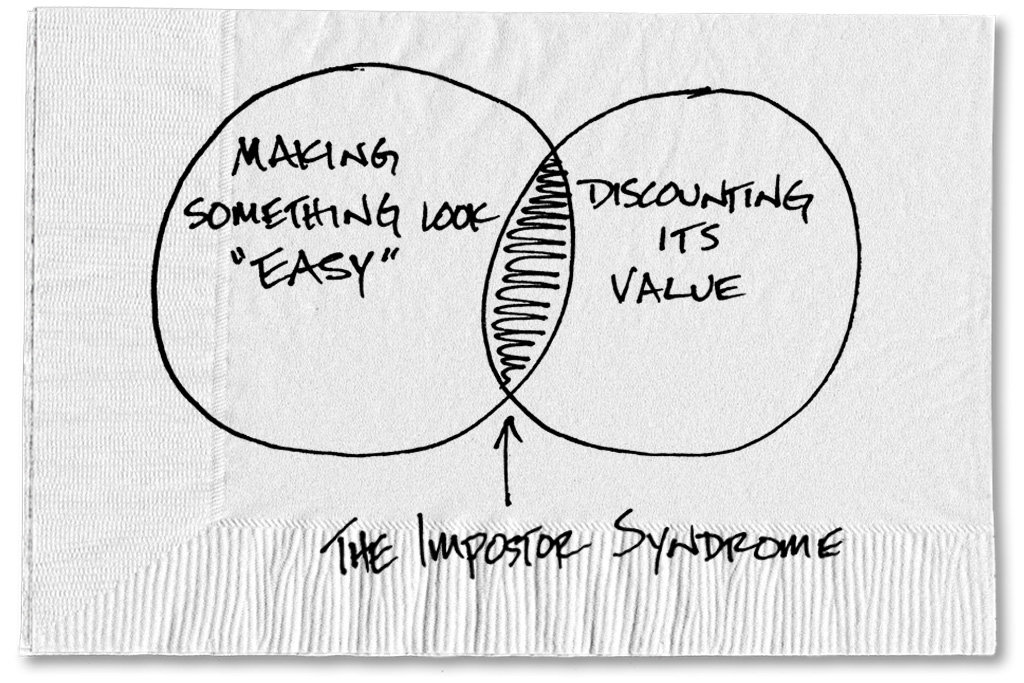 Photo credit: Carl Richards
Photo credit: Carl Richards
We all have an imposter syndrome story.
Here’s my imposter syndrome story.
Very early in my career, I had been trained on how to manage projects using a Project Management Plan (PMP) model. For years, we used this model to get projects done. It was effective and efficient. Everyone in our department knew how to use this model.
Years later, I decided to transfer to another department. I wanted to work in Marketing, but when I got there, absolutely no one knew how to run a project. It was chaos. They didn’t track progress; didn’t assign roles and responsibilities; they didn’t know their budgets or how much certain initiatives would cost; and they didn’t recognize milestones or small wins.
So, I taught them how to do this. I helped them create workplans, allocate resources, estimate costs, track deliverables, and stay on budget.
It was simple … and I made it look easy.
What happened?
I decided to work as a consultant, and they started paying me more and more money to keep showing them how to do this. They asked for my feedback; put me on the biggest marketing campaigns; asked me to reorganize their teams and find better efficiencies. And they made it clear that I had something of value to give them and they were willing to pay plenty of money for me to keep them running smoothly. And this went on for years.
What did I think?
– This has to be a joke.
– They can’t possibly find this valuable.
– They’ll eventually figure out that anybody can do this.
– I can’t believe they’re paying me for this.
Unfortunately, this mindset also went on for years. It was an uncomfortable reality for me. I worked very hard and I had many credible accomplishments. Top executives respected my point of view and asked for my opinion and feedback.
But I discounted most of it … if it’s easy, then it’s not really work, is it?
Imposter syndrome is a very real state of mind and if it goes unchecked, it can create much more stress than necessary, especially at work. For some people, they may feel this way temporarily until they get their bearings in a new job or position. For others, this could be a chronic state of mind that will require constant attention and shifts in mindset.
To learn more about how to overcome feelings of imposter syndrome, read on for five articles on overcoming imposter syndrome, including the different types of imposter syndrome you may experience during any given situation.
1. Learning to deal with the imposter syndrome.
Like Carl Richards says, “It’s at the moment when you’re most vulnerable that all your doubts come crashing in around you.” He further explains that what becomes naturally easy for us can lead us to discount its value to the world.This article is a short but powerful essay he wrote for The New York Times that gets to the heart of how to deal with these feelings — invite them in and see what happens.
2. The five different types of imposter syndrome.
This article from The Muse provides a great framework for understanding the different types of imposter syndrome. The framework came from Dr. Valerie Young, who outlines these types in her book. She identifies them as the Perfectionist, the Superwoman/man, the Natural Genius, the Soloist, or the Expert. The article also provides great coaching questions to get you to understand each type and where you may identify with one over the others.
3. The 10-step process to change IS thinking.
Did you know there is actually a website called impostersyndrome.com? Valerie Young runs the site. As a writer, speaker, and educator on imposter syndrome, she has some great insight. This article on her blog outlines the 10 steps that she uses with clients to help them out of this mindset. She also shares a link to her TED talk on the same subject.
4. Five ways to overcome imposter syndrome in the workplace.
This Business Insider article looks at imposter syndrome from the other perspective. As a leader, what are you observing about your team? This article explores the types of workplace cultures that help foster feelings of imposter syndrome. It also gives examples of behaviors from employees who are struggling, and it gives ideas and solutions for moving a team forward.
5. How to reduce the negative effects of IS.
There are some common thoughts and feelings that surface when we’re facing imposter syndrome. This article by Harvard Business Review digs into the internal dialogue that happens, as well as strategies that help limit the impact of these feelings in stressful situations.
On a final note, imposter syndrome is a very complicated emotional state. For some people, they may feel this way temporarily until they get their bearings in a new job or position. For others, this could be a chronic state of mind that will require constant attention and shifts in mindset.
If you’ve ever experienced imposter syndrome yourself, drop me a note and let me know how you dealt with it. For me, I needed to acknowledge that different people come with different skills, and I just happened to be able to help a group of people work more efficiently. That is my talent.
Christina Holloway was recently named the #1 Executive Coach in Chicago by Influence Digest. She is an executive coach and business strategist helping executives and entrepreneurs find success. You can find Christina’s thought leadership in Forbes, The Huffington Post, Addicted2Success, and Fast Company. If you’re interested in working with Christina, take a look at her strategy sessions and contact her to get started.

